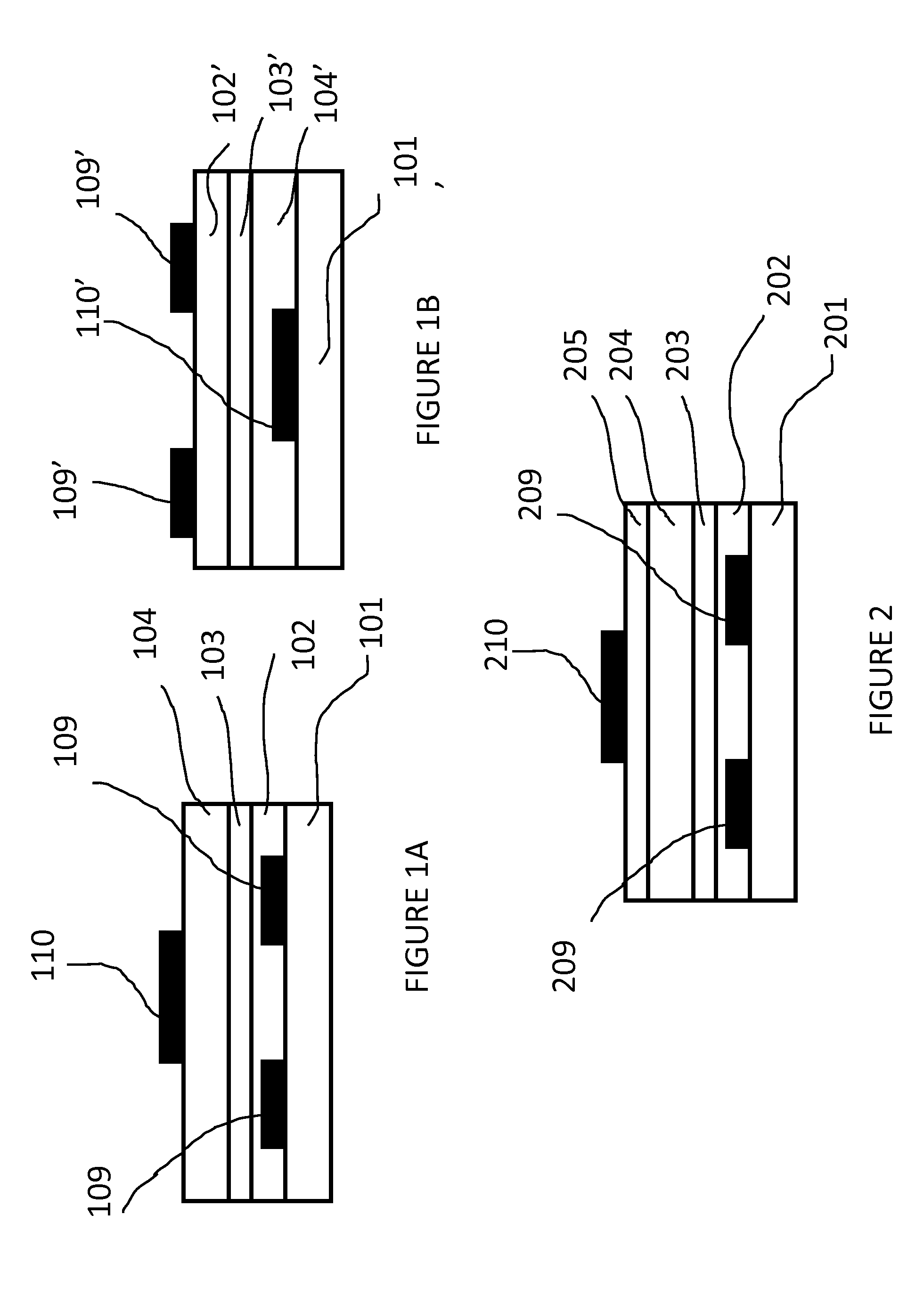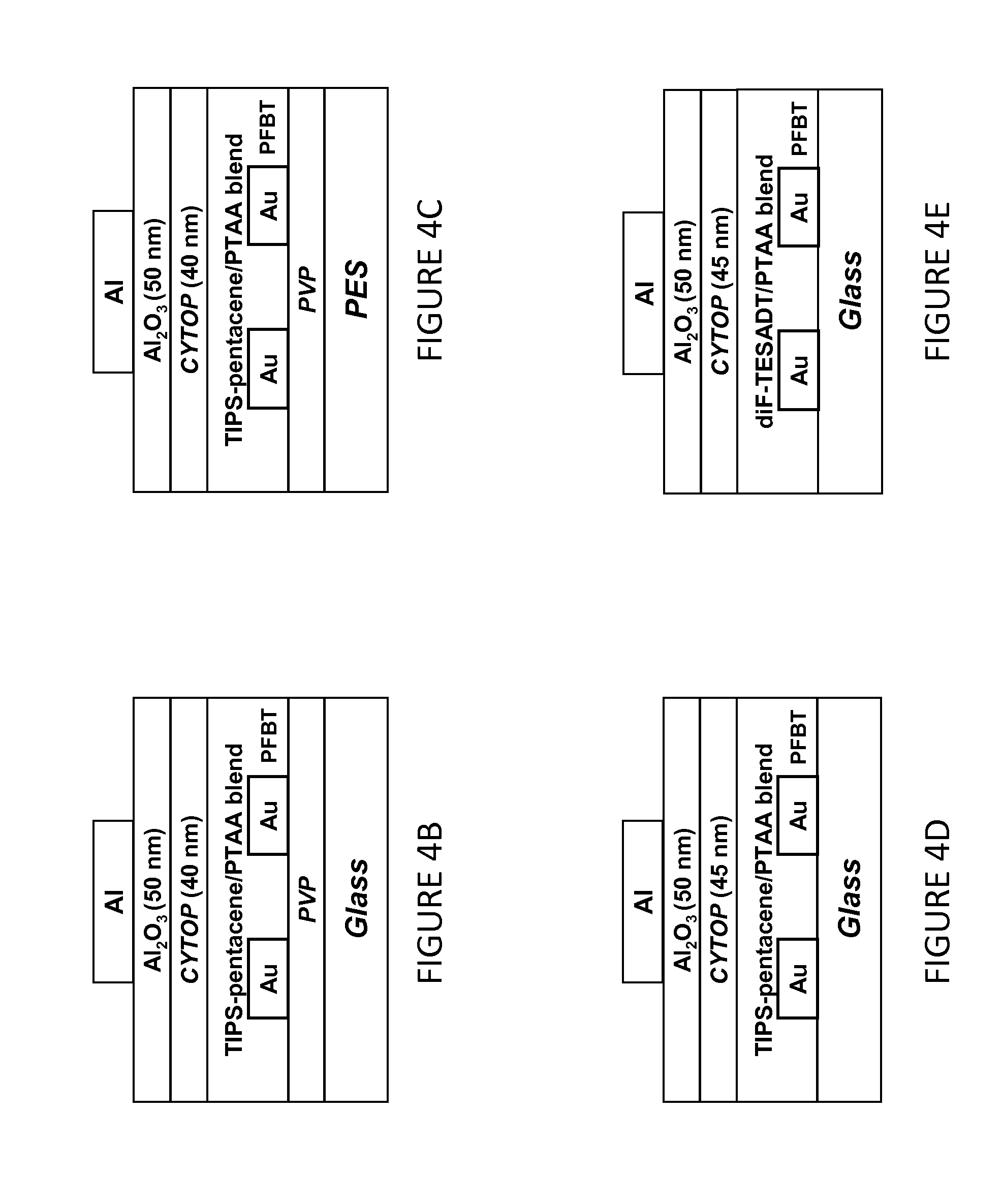Field-effect transistor and manufacturing process thereof
- Summary
- Abstract
- Description
- Claims
- Application Information
AI Technical Summary
Benefits of technology
Problems solved by technology
Method used
Image
Examples
example 1
TIPS-Pentacene and Poly (Triarylamine) (PTAA) Blend Channel Based OFET with CYTOP / Al2O3 Bi-Layer Using Glass Substrate (40 nm CYTOP; 50 nm Al2O3)
[0094]OFETs with a bottom-contact and top-gate structure were fabricated on glass substrates (Corning 1737). Poly-4-vinylphenol (PVP) buffer layers were prepared from 2 wt. % solutions of PVP (Mw˜20,000) and poly (melamine-co-formaldehyde), as a cross-linking agent, in propylene glycol monomethyl ether acetate (PGMEA), which were deposited by spin coating at 3000 rpm for 40 sec and subsequently cross-linked at 175° C. on a hot plate for 1 h in a N2-filled glove box. Au (50 nm) bottom-contact source / drain electrodes were deposited by thermal evaporation through a shadow mask. A self-assembled monolayer of pentafluorobenzenethiol (PFBT) was formed on the Au electrodes by immersion in a 10 mmol PFBT solution in ethanol for 15 min in a N2-filled dry box, rinsing with pure ethanol, and drying. The TIPS-pentacene and PTAA blend solution was prepa...
example 2
Pentacene Channel Based OFET
[0095]The top gate pentacene OFETs were fabricated with a geometry incorporating a bottom source / drain electrodes. Au (80 nm) bottom contact source / drain electrodes were deposited by electron-beam (e-beam) at room temperature on a glass substrate through a shadow mask. A pentacene active layer (50 nm) was then deposited by thermal evaporation at room temperature through a shadow mask. CYTOP (40 nm) / Al2O3 (50 nm) layers were used as a top gate dielectric. CYTOP (40 nm) layers were coated by spin casting at 3000 rpm for 60 seconds. The CYTOP films were annealed at 100° C. for 20 min. Al2O3 dielectric films were grown at 110° C. using alternating exposures of trimethyl aluminum [Al(CH3)3] and H2O vapor at a deposition rate of approximately 0.1 nm per cycle. Then, Al electrode was sequentially deposited by e-beam to form the gate electrode.
example 3
InGaZnO Channel Based Oxide FET
[0096]The top gate amorphous InGaZnO FET was fabricated with a geometry incorporating a bottom source / drain electrodes. First, a tri-layer of Ti (6 nm) / Au (50 nm) / Ti (6 nm) was deposited using electron-beam (e-beam) at room temperature on a glass substrate (Corning 1737) and patterned by photolithography followed by a lift-off process. A 40 nm-thick a-IGZO (Ga2O3:In2O3:ZnO=1:1:2 mol %) active layer was then deposited by radio frequency (RF) sputtering. After deposition of the a-IGZO layer, the device was annealed. To define the channel, the a-IGZO layer was patterned by a wet-etching process using hydrochloric acid (HCl:H2O=1:100) diluted in DI water. CYTOP (40 nm) / Al2O3 (50 nm) layers were used as top gate dielectrics. Al2O3 dielectric films were grown at 110° C. using alternating exposures of trimethyl aluminum [Al(CH3)3] and H2O vapor. For 40 nm CYTOP layer, a 2 wt % solution was used, which was diluted with solvent. CYTOP (40 nm) layers were coated...
PUM
 Login to View More
Login to View More Abstract
Description
Claims
Application Information
 Login to View More
Login to View More - R&D
- Intellectual Property
- Life Sciences
- Materials
- Tech Scout
- Unparalleled Data Quality
- Higher Quality Content
- 60% Fewer Hallucinations
Browse by: Latest US Patents, China's latest patents, Technical Efficacy Thesaurus, Application Domain, Technology Topic, Popular Technical Reports.
© 2025 PatSnap. All rights reserved.Legal|Privacy policy|Modern Slavery Act Transparency Statement|Sitemap|About US| Contact US: help@patsnap.com



